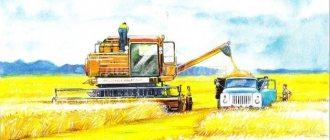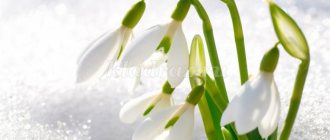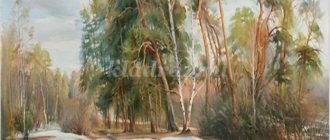Summary of educational activities for speech development in the senior group on the topic: Spring
Synopsis of the educational activity on the development of speech “Spring has come” for children of the senior group
Author: Vitskova Marina Viktorovna, teacher of the MBDOU “Kindergarten “Goldfish” of the Astrakhan region, Chernoyarsk district. This material will be useful for educators when conducting conversations and educational activities on the topic: “Spring” with children of the older group. Goal: to promote a generalization of ideas about spring as a season, about weather conditions in spring. Objectives: Deepen understanding of seasonal changes in nature; Continue to introduce children to folklore works about spring; develop logical thinking, coherent speech, enrich and activate vocabulary, develop communication skills. To cultivate responsiveness in children, to form a positive emotional attitude towards the beauty of spring nature. Materials: Pictures depicting signs and signs of spring. Preliminary work: Examination with children of illustrations about spring, spring changes in nature, conversations with children about the signs of spring, about signs. Reading fiction about spring, memorizing poems about spring, asking riddles, sayings and proverbs.
GCD
Educator. Hello guys.
Now I’ll tell you a riddle, and you guess it. Mystery.
The streams rang, the rooks flew in.
The bee brought the first honey to her hive. Who can say, who knows, When this happens? Children. In the spring Educator. Now we'll play a game.
A didactic game is being played: “Spring words”
Purpose. Practice choosing definitions for nouns. — What is the sky like in winter? Children. (Clear, gloomy, low, heavy. cold, gloomy.) What is the sky like in spring? Children. (Blue, bright, clean, spring, high, cheerful. clear.) - What kind of sun is it in spring? Children. (Bright, radiant, warm, affectionate.) What kind of grass is it in the spring? Children. (Young, green, first, tender, fragrant.) Educator. Guys, now I suggest you choose definitions for the word Spring. Spring, what is it like? Children. Spring is early, sunny, festive, rainy, long-awaited, warm, joyful. Educator. A stream in the forest laughs, And a starling sings in the garden. The sun is getting hotter, And winter is coming to an end. The first little snowdrop Awoke from sleep, He straightened his petals: - I have grown up, spring has come! Educator. Children, tell me the signs of spring? Children. The early arrival of a lark means early spring. When the blackbirds arrive, it means there will be no more frosts. If a woodpecker is seen in March, then spring will be late. If you see a starling, know: spring is on the doorstep. There are a lot of cobwebs in spring - there will be a hot summer. Educator. Guys, what spring months do you know? Children. March April May. Educator. Tell me, what proverbs and sayings about spring are you familiar with? Children. Spring is like a peahen: beauty and glory to the whole world. Spring is red and hungry. No matter how the frog pouts, it’s still far from the ox. The frog in the well does not know about the sea. There would be a swamp, but there would be frogs. Every sandpiper is great in its swamp. Even the frog sings in his swamp. Spring - the redness of winter - brings the zemstvo to nothing. One swallow does not make spring. Educator. Guys, do you like spring, and what does it do, what words can you say from it? Children. Spring is coming, coming, coming, blooming, approaching, smelling. A didactic game is being played: “Name it in one word” Goal: expand and activate vocabulary. Strengthen the skills of word formation of nouns. A flower that blooms immediately after the snow melts. Children. Snowdrop. A place where the snow melted and the earth opened up. Children. Thaw Warm weather with melting snow and ice. Children. Thaw. The first flower to appear in early spring. Children. Primrose. Falling drops of thawed snow. Children. Drops.
Physical school is being held
Spring, spring!
Spring came! Clap your hands.
She brought warmth on her wings.
Short flaps of the arms and wings
And then in the very sun,
Walking.
With your proud head raised.
Raise your chin higher.
The blue snowdrop blossomed.
Hands to the side.
He's all fluffy, silver,
Squats.
The little one stands in the sun.
Jumping.
He is a reliable messenger of spring,
tilts his torso.
He is not afraid of cold weather.
Other flowers will come after him, Turns left and right.
He is the firstborn among flowers.
Educator. Guys, what do you think Spring smells like? Children. Spring smells of freshness, flowers, grass . Educator. Now tell me what spring holidays do you know? Children. World Cat Day, March 8, World Water Day, Earth Day, Writer's Day, Laughter Day, Bird Day, Health Day, Cosmonautics Day, Spring and Labor Day, Sun Day, Victory Day, Family Day, Border Guard Day. Educator. Well done guys, did a very good job! Educator. What time of year were we talking about today? What signs and signs of spring do you remember? (Children's answers)
We recommend watching:
Summary of a comprehensive lesson in the senior group on the topic: Spring Summary of the lesson for children of the senior group. The beauty of the native land Abstract OD on a spring theme in kindergarten in the senior group. Journey to the world of spring Thematic spring music lesson in the senior group “Spring sounds and colors”
Similar articles:
Summary of a lesson on a spring topic in the senior group. Description of the painting by Savrasov “The Rooks Have Arrived”
Walking in the senior group. Card file with goals for March
Walking in the senior group. Card file with goals for April
Walking in the senior group. Card file with goals for May
Spring came. Summary of a lesson on speech development (senior group)
Summary of a lesson on speech development “Spring has come” (senior group) Objectives: continue to acquaint children with spring changes in nature, teach them to describe a picture, and name the characteristic signs of spring. Expand children's knowledge about nature and seasonal changes. Form grammatically correct speech, develop the ability to select adjectives for the main word. Strengthen the ability to read poetry. Continue teaching children to draw a landscape. Course of the lesson I. Organizational moment - Guys, today a magpie flew into the kindergarten from afar and brought the following news: spring has already come. The snow has melted! The snow has melted! This news is not easy! This means real spring is coming. -Are you happy about spring? Show how excited you are for spring. (Children use facial expressions to depict joy.) Now tell this news joyfully: “Spring has come!” (Children repeat the sentence with different intonations) - And the magpie wants to tell you another secret, that today 4 sisters who are very friendly with each other want to come to visit us. Listen to a riddle about one of the sisters. I have a lot of things to do - I open the buds, I dress the trees in green leaves, I water the crops, I am full of movement, My name is... (Spring) An illustration of spring is exhibited. – Spring has 3 sisters. Let's try to guess them. I have a lot of things to do - I cover the whole earth with a white blanket, I clean the ice from the rivers, I whiten the fields, the houses. My name is... (Winter) I am woven from the heat, I carry the warmth with me. I warm the rivers, I invite you to swim, and you all love me for it. I... (Summer) I bring the harvests, I sow the fields again, I send the birds to the south, I strip the trees, But without touching the pines and fir trees. I... (Autumn) - All year round the sisters dance in circles one after another, changing each other. Oh guys, did our sisters stand up correctly? What's happened? Will winter really come after spring again? (Children help sequentially arrange pictures depicting the seasons) Game “Reverse”. - Guys, look outside the window, what time of year is it now? - Spring. - That's right, how did you guess? “It’s getting warm, the snow is melting, the trees are waking up, flowers are appearing, birds are flying in.” - Right. How much do you know about spring, but won’t you confuse winter with spring? Whoever I put a magic wand in his hands will answer. Winter is gone, and spring... has come. Winter is cold and spring... warm. In winter the sun freezes, and in spring... it warms. In winter the snowdrifts are high, and in spring... low. “Spring” (I. Tokmakova) Spring is coming towards us with quick steps, And the snowdrifts are melting under its feet. Black thawed patches are visible in the fields. You can see very warm feet in spring. Guys, what is this poem talking about? (It talks about how winter gives way to spring). - Why do you think spring is coming to us with rapid steps? — What happens to the snowdrifts? - Think about it, why are black thawed patches visible? (The sun warmed up, it became warmer). - Yes, Spring has come - it’s red. This is what people called spring because it is very beautiful, everyone rejoiced at its arrival: both children and adults. - Listen, guys, what did people call the spring months and try to guess why? Mart-drip. April is Aquarius. May-grass, pollen. — Spring is a celebration of the awakening of nature. All people, animals, plants expect joy and warmth from spring. -Listen, guys, how composer P.I. Tchaikovsky told us about spring. Children listen to “The Seasons” by P. I. Tchaikovsky. Educator: let's try to enter the picture: - What sounds do you hear? - What smells do you smell? — What can you call the painting? “I brought spring paintings to class,” the teacher shows. Guess why I called them spring”? (show slides depicting spring phenomena in different periods, animals, birds and plants in spring.) - Guys, let's remember and look at the pictures what changes occur in nature in spring. —What does the sky look like in spring? (Blue, light, cloudless). And the sun? (Warm, bright, affectionate, spring). — What happens to the snow? (With the onset of warm days, thawed patches appear in the snow, the snow begins to melt, streams flow, and icicles hang from the roofs). - How many of you guys know what drops are? (droplets of water often, often drip from the roofs). - What happens to the kidneys? (the buds burst and small leaves bloom). — — How do you understand the words “The day is coming”? (The days are getting longer and the nights are getting shorter - Why do people say this: “The rook opens the spring?” - Why are there so many birds in the spring? What are they so concerned about? (They flew in from warm regions, making nests.) - And in the spring, what do they eat, birds? (Insects appear in the spring, and birds feed on them.) - That's right. Bugs, spiders, insect pupae spent the entire cold winter under the bark of trees, hiding in old stumps, in the ground. Changes also occur in the lives of animals (in the spring, animals have babies , winter wool is replaced by summer wool) - What happens to those animals that have been sleeping all winter? (Hedgehogs, bears, badgers wake up from hibernation in the spring). - In the spring, the first flowers appear, and which ones? (primrose, coltsfoot) -What did spring give to our site? (“Flowers: dandelions, tulips. Butterflies, beetles, thick grass.”) - Guys, what beautiful words can you say about spring? (Spring is red, sunny, affectionate, warm, green, beautiful, etc. .(several children make up a story based on the picture) Physical exercise Come, spring, with joy, With joy, with joy, With great mercy: With high flax, With deep roots, “Signs of Spring” Educator: Children in the spring, new bright colors appeared in nature. Which? (Leaves, grass - green; sky, icicles - blue; sun - bright yellow; many first flowers of bright colors, etc.) Now prepare a sheet of paper and colored pencils. (talk to the children about spring and offer a game - find and draw) Guys, now we will draw the signs of spring. (You can tell what kind of clothes they wear in winter. And what kind of clothes do they wear in spring? A jacket, and in winter they wore a warm fur coat, a thick sweater, woolen mittens and socks. The sun is warming up, and it has become warmer outside - this is the first sign of spring. We draw the sun. The sun is hot, so the snow melts and streams run. So we have found the second sign of spring. We draw streams or puddles. In People say that if the willow blossomed, the coltsfoot blossomed and young grass appeared, spring has come. We have identified the third sign of spring - we draw grass. Tender buds swell on the trees, catkins appear on birch and poplar, followed by young leaves. , earrings, leaves - this is another sign of spring. Draw a birch tree with leaves together. Pay attention to the sparrows: they chirp happily, fuss, drag dry twigs and blades of grass. They rejoice in spring. Birds that flew away for the winter began to appear - starlings, rooks , swallows. (The birds themselves are not so easy to see, so we will show photographs or drawings of birds). Together we will draw a bird (or maybe more than one bird). End of class. The teacher invites the children to remember what they were talking about and list the games and exercises they liked.




